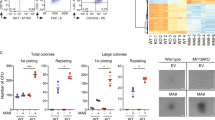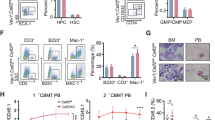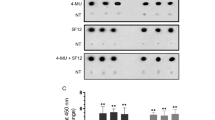Abstract
PHLPP2, a member of the PH-domain leucine-rich repeat protein phosphatase (PHLPP) family, which targets oncogenic kinases, has been actively investigated as a tumor suppressor in solid tumors. Little is known, however, regarding its regulation in hematological malignancies. We observed that PHLPP2 protein expression, but not its mRNA, was suppressed in late differentiation stage acute myeloid leukemia (AML) subtypes. MicroRNAs (miR or miRNAs) from the miR-17–92 cluster, oncomir-1, were shown to inhibit PHLPP2 expression and these miRNAs were highly expressed in AML cells that lacked PHLPP2 protein. Studies showed that miR-17–92 cluster regulation was, surprisingly, independent of transcription factors c-MYC and E2F in these cells; instead all-trans-retinoic acid (ATRA), a drug used for terminally differentiating AML subtypes, markedly suppressed miR-17–92 expression and increased PHLPP2 protein levels and phosphatase activity. Finally, we demonstrate that the effect of ATRA on miR-17–92 expression is mediated through its target, transcription factor C/EBPβ, which interacts with the intronic promoter of the miR-17–92 gene to inhibit transactivation of the cluster. These studies reveal a novel mechanism for upregulation of the phosphatase activity of PHLPP2 through C/EBPβ-mediated repression of the miR-17–92 cluster in terminally differentiating myeloid cells.
Similar content being viewed by others
Log in or create a free account to read this content
Gain free access to this article, as well as selected content from this journal and more on nature.com
or
Abbreviations
- 3’UTR:
-
3’ untranslated region
- AML:
-
acute myeloid leukemia
- ATRA:
-
all-trans-retinoic acid
- APL:
-
acute promyelocytic leukemia
- FAB:
-
French–American–British
- miR or miRNA:
-
microRNA
References
McConnell JL, Wadzinski BE . Targeting protein serine/threonine phosphatases for drug development. Mol Pharmacol 2009; 75: 1249–1261.
Gao T, Furnari F, Newton AC . PHLPP: a phosphatase that directly dephosphorylates Akt, promotes apoptosis, and suppresses tumor growth. Mol Cell 2005; 18: 13–24.
Warfel NA, Newton AC . Pleckstrin homology domain leucine-rich repeat protein phosphatase (PHLPP): a new player in cell signaling. J Biol Chem 2012; 287: 3610–3616.
Brognard J, Newton AC . PHLiPPing the switch on Akt and protein kinase C signaling. Trends Endocrinol Metab 2008; 19: 223–230.
Brognard J, Sierecki E, Gao T, Newton AC . PHLPP and a second isoform, PHLPP2, differentially attenuate the amplitude of Akt signaling by regulating distinct Akt isoforms. Mol Cell 2007; 25: 917–931.
Liu J, Stevens PD, Li X, Schmidt MD, Gao T . PHLPP-mediated dephosphorylation of S6K1 inhibits protein translation and cell growth. Mol Cell Biol 2011; 31: 4917–4927.
Qiao M, Wang Y, Xu X, Lu J, Dong Y, Tao W et al. Mst1 is an interacting protein that mediates PHLPPs' induced apoptosis. Mol Cell 2010; 38: 512–523.
O'Neill AK, Niederst MJ, Newton AC . Suppression of survival signalling pathways by the phosphatase PHLPP. FEBS J 2013; 280: 572–583.
Liu J, Stevens PD, Gao T . mTOR-dependent regulation of PHLPP expression controls the rapamycin sensitivity in cancer cells. J Biol Chem 2011; 286: 6510–6520.
Cai J, Fang L, Huang Y, Li R, Yuan J, Yang Y et al. miR-205 targets PTEN and PHLPP2 to augment AKT signaling and drive malignant phenotypes in non-small cell lung cancer. Cancer Res 2013; 73: 5402–5415.
Liao WT, Li TT, Wang ZG, Wang SY, He MR, Ye YP et al. microRNA-224 promotes cell proliferation and tumor growth in human colorectal cancer by repressing PHLPP1 and PHLPP2. Clin Cancer Res 2013; 19: 4662–4672.
Rao E, Jiang C, Ji M, Huang X, Iqbal J, Lenz G et al. The miRNA-17~ 92 cluster mediates chemoresistance and enhances tumor growth in mantle cell lymphoma via PI3K/AKT pathway activation. Leukemia 2012; 26: 1064–1072.
He L, Thomson JM, Hemann MT, Hernando-Monge E, Mu D, Goodson S et al. A microRNA polycistron as a potential human oncogene. Nature 2005; 435: 828–833.
Olive V, Li Q, He L . mir-17-92: a polycistronic oncomir with pleiotropic functions. Immunol Rev 2013; 253: 158–166.
Inomata M, Tagawa H, Guo YM, Kameoka Y, Takahashi N, Sawada K . MicroRNA-17-92 down-regulates expression of distinct targets in different B-cell lymphoma subtypes. Blood 2009; 113: 396–402.
Hayashita Y, Osada H, Tatematsu Y, Yamada H, Yanagisawa K, Tomida S et al. A polycistronic microRNA cluster, miR-17-92, is overexpressed in human lung cancers and enhances cell proliferation. Cancer Res 2005; 65: 9628–9632.
Lu J, Getz G, Miska EA, Alvarez-Saavedra E, Lamb J, Peck D et al. MicroRNA expression profiles classify human cancers. Nature 2005; 435: 834–838.
Mogilyansky E, Rigoutsos I . The miR-17/92 cluster: a comprehensive update on its genomics, genetics, functions and increasingly important and numerous roles in health and disease. Cell Death Differ 2013; 20: 1603–1614.
Nagel S, Venturini L, Przybylski GK, Grabarczyk P, Schmidt CA, Meyer C et al. Activation of miR-17-92 by NK-like homeodomain proteins suppresses apoptosis via reduction of E2F1 in T-cell acute lymphoblastic leukemia. Leuk Lymphoma 2009; 50: 101–108.
Tagawa H, Seto M . A microRNA cluster as a target of genomic amplification in malignant lymphoma. Leukemia 2005; 19: 2013–2016.
Wang F, Li T, Zhang B, Li H, Wu Q, Yang L et al. MicroRNA-19a/b regulates multidrug resistance in human gastric cancer cells by targeting PTEN. Biochem Biophys Res Commun 2013; 434: 688–694.
O'Donnell KA, Wentzel EA, Zeller KI, Dang CV, Mendell JT . c-Myc-regulated microRNAs modulate E2F1 expression. Nature 2005; 435: 839–843.
Sylvestre Y, De Guire V, Querido E, Mukhopadhyay UK, Bourdeau V, Major F et al. An E2F/miR-20a autoregulatory feedback loop. J Biol Chem 2007; 282: 2135–2143.
Woods K, Thomson JM, Hammond SM . Direct regulation of an oncogenic micro-RNA cluster by E2F transcription factors. J Biol Chem 2007; 282: 2130–2134.
Yan HL, Xue G, Mei Q, Wang YZ, Ding FX, Liu MF et al. Repression of the miR-17-92 cluster by p53 has an important function in hypoxia-induced apoptosis. EMBO J 2009; 28: 2719–2732.
Lowenberg B, Downing JR, Burnett A . Acute myeloid leukemia. N Engl J Med 1999; 341: 1051–1062.
Cerami E, Gao J, Dogrusoz U, Gross BE, Sumer SO, Aksoy BA et al. The cBio cancer genomics portal: an open platform for exploring multidimensional cancer genomics data. Cancer Discov 2012; 2: 401–404.
Gao J, Aksoy BA, Dogrusoz U, Dresdner G, Gross B, Sumer SO et al. Integrative analysis of complex cancer genomics and clinical profiles using the cBioPortal. Sci Signal 2013; 6 pl1.
Li X, Stevens PD, Yang H, Gulhati P, Wang W, Evers BM et al. The deubiquitination enzyme USP46 functions as a tumor suppressor by controlling PHLPP-dependent attenuation of Akt signaling in colon cancer. Oncogene 2013; 32: 471–478.
Campone M, Noel B, Couriaud C, Grau M, Guillemin Y, Gautier F et al. c-Myc dependent expression of pro-apoptotic Bim renders HER2-overexpressing breast cancer cells dependent on anti-apoptotic Mcl-1. Mol Cancer 2011; 10: 110.
Breitman TR, Selonick SE, Collins SJ . Induction of differentiation of the human promyelocytic leukemia cell line (HL-60) by retinoic acid. Proc Natl Acad Sci USA 1980; 77: 2936–2940.
Cull EH, Altman JK . Contemporary treatment of APL. Curr Hematol Malig Rep 2014; 9: 193–201.
Degos L, Dombret H, Chomienne C, Daniel MT, Miclea JM, Chastang C et al. All-trans-retinoic acid as a differentiating agent in the treatment of acute promyelocytic leukemia. Blood 1995; 85: 2643–2653.
Gallagher R, Collins S, Trujillo J, McCredie K, Ahearn M, Tsai S et al. Characterization of the continuous, differentiating myeloid cell line (HL-60) from a patient with acute promyelocytic leukemia. Blood 1979; 54: 713–733.
Billottet C, Banerjee L, Vanhaesebroeck B, Khwaja A . Inhibition of class I phosphoinositide 3-kinase activity impairs proliferation and triggers apoptosis in acute promyelocytic leukemia without affecting ATRA-induced differentiation. Cancer Res 2009; 69: 1027–1036.
Takitani K, Koh M, Zhu CL, Inoue A, Kuno T, Tanoue H et al. Expression of retinoic acid receptor-target genes during retinoic acid therapy for acute promyelocytic leukemia. Leukemia 2003; 17: 646–648.
Zhang JW, Wang JY, Chen SJ, Chen Z . Mechanisms of all-trans retinoic acid-induced differentiation of acute promyelocytic leukemia cells. J Biosci 2000; 25: 275–284.
Duprez E, Wagner K, Koch H, Tenen DG . C/EBPbeta: a major PML-RARA-responsive gene in retinoic acid-induced differentiation of APL cells. EMBO J 2003; 22: 5806–5816.
Huber R, Pietsch D, Panterodt T, Brand K . Regulation of C/EBPbeta and resulting functions in cells of the monocytic lineage. Cell Signal 2012; 24: 1287–1296.
Monteys AM, Spengler RM, Wan J, Tecedor L, Lennox KA, Xing Y et al. Structure and activity of putative intronic miRNA promoters. RNA 2010; 16: 495–505.
Osada S, Yamamoto H, Nishihara T, Imagawa M . DNA binding specificity of the CCAAT/enhancer-binding protein transcription factor family. J Biol Chem 1996; 271: 3891–3896.
Ota A, Tagawa H, Karnan S, Tsuzuki S, Karpas A, Kira S et al. Identification and characterization of a novel gene, C13orf25, as a target for 13q31-q32 amplification in malignant lymphoma. Cancer Res 2004; 64: 3087–3095.
Garofalo M, Croce CM . microRNAs: master regulators as potential therapeutics in cancer. Annu Rev Pharmacol Toxicol 2011; 51: 25–43.
Ventura A, Young AG, Winslow MM, Lintault L, Meissner A, Erkeland SJ et al. Targeted deletion reveals essential and overlapping functions of the miR-17 through 92 family of miRNA clusters. Cell 2008; 132: 875–886.
Alemdehy MF, Erkeland SJ . MicroRNAs: key players of normal and malignant myelopoiesis. Curr Opin Hematol 2012; 19: 261–267.
Bundy LM, Sealy L . CCAAT/enhancer binding protein beta (C/EBPbeta)-2 transforms normal mammary epithelial cells and induces epithelial to mesenchymal transition in culture. Oncogene 2003; 22: 869–883.
Kim MH, Fields J . Translationally regulated C/EBP beta isoform expression upregulates metastatic genes in hormone-independent prostate cancer cells. Prostate 2008; 68: 1362–1371.
Zahnow CA, Younes P, Laucirica R, Rosen JM . Overexpression of C/EBPbeta-LIP, a naturally occurring, dominant-negative transcription factor, in human breast cancer. J Natl Cancer Inst 1997; 89: 1887–1891.
Sachdeva M, Liu Q, Cao J, Lu Z, Mo YY . Negative regulation of miR-145 by C/EBP-beta through the Akt pathway in cancer cells. Nucleic Acids Res 2012; 40: 6683–6692.
Mueller BU, Pabst T, Fos J, Petkovic V, Fey MF, Asou N et al. ATRA resolves the differentiation block in t(15;17) acute myeloid leukemia by restoring PU.1 expression. Blood 2006; 107: 3330–3338.
Lowman XH, McDonnell MA, Kosloske A, Odumade OA, Jenness C, Karim CB et al. The proapoptotic function of Noxa in human leukemia cells is regulated by the kinase Cdk5 and by glucose. Mol Cell 2010; 40: 823–833.
Acknowledgements
For valuable technical advice, we thank Lihua Li and Jyotika Varshney from the Subramanian laboratory. This work was supported by NIH grant R01 CA157971 to AK and American Cancer Society grant RSG-13-381-01 to SS, NIHT32 (CA009138) training fellowships to EAH and JMB, F31 award (CA177119) to EAH, and a doctoral dissertation award to XHL.
Author information
Authors and Affiliations
Corresponding author
Ethics declarations
Competing interests
The authors declare no conflict of interest.
Additional information
Edited by SH Kaufmann
Supplementary Information accompanies this paper on Cell Death and Differentiation website
Rights and permissions
About this article
Cite this article
Yan, Y., Hanse, E., Stedman, K. et al. Transcription factor C/EBP-β induces tumor-suppressor phosphatase PHLPP2 through repression of the miR-17–92 cluster in differentiating AML cells. Cell Death Differ 23, 1232–1242 (2016). https://doi.org/10.1038/cdd.2016.1
Received:
Revised:
Accepted:
Published:
Issue date:
DOI: https://doi.org/10.1038/cdd.2016.1
This article is cited by
-
The possible correlation between miR-762, Hippo signaling pathway, TWIST1, and SMAD3 in lung cancer and chronic inflammatory diseases
Scientific Reports (2024)
-
The microRNA-17 ~ 92 Family as a Key Regulator of Neurogenesis and Potential Regenerative Therapeutics of Neurological Disorders
Stem Cell Reviews and Reports (2022)
-
Adipocyte PHLPP2 inhibition prevents obesity-induced fatty liver
Nature Communications (2021)
-
Phosphatase PHLPP2 regulates the cellular response to metabolic stress through AMPK
Cell Death & Disease (2021)
-
The transcription factor TAL1 and miR-17-92 create a regulatory loop in hematopoiesis
Scientific Reports (2020)



